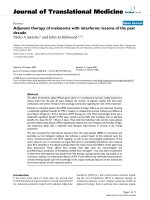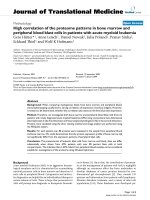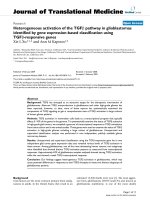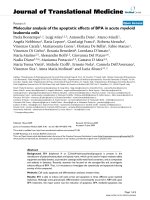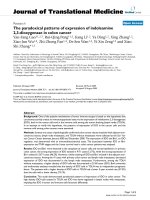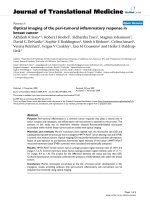Báo cáo hóa học: " The existence of solutions to the nonhomogeneous A-harmonic equation" docx
Bạn đang xem bản rút gọn của tài liệu. Xem và tải ngay bản đầy đủ của tài liệu tại đây (360.79 KB, 13 trang )
RESEARCH Open Access
The existence of solutions to the
nonhomogeneous
A
-harmonic equation
Guanfeng Li, Yong Wang
*
and Gejun Bao
* Correspondence: mathwy@hit.
edu.cn
Department of Mathematics,
Harbin Institute of Technology,
Harbin 150001, People’s Republic
of China
Abstract
In this paper, we introduce the obstacl e problem about the nonhomogeneous
A
-harmonic equation. Then, we prove the existence and uniqueness of solutions to
the nonhomogeneous
A
-harmonic equation and the obstacle problem.
Keywords: the obstacle problem, the nonhomogeneous A-harmonic equation, exis-
tence and uniqueness of solutions
1 Introduction
In this paper, we study the nonhomogeneous
A
-harmonic equation
−divA
(
x, ∇u
(
x
))
= f
(
x
),
where
A
: R
n
× R
n
→ R
n
is an operator and f is a function s atisfying some a ssump-
tions given in the next section. We give the definition of solutions to the nonhomoge-
neous
A
-harmonic equation and the obstacle problem. In the mean time, we s how
some properties of their solutions. Then, we pro ve the existence and uniqueness of
solutions to the Dirichlet problem for the nonhomogeneous
A
-harmonic equation with
Sobolev boundary values.
Let ℝ
n
be the real Euclidean space with the dimensio n n. Throughout this paper, all
the topological notions are taken wi th respect to ℝ
n
. E ⋐ F means that
¯
E
is a compact
subset of F. C(Ω) is the set of all continuous functions u : Ω ® ℝ. sptu is the s mal-
lest closed set such that u vanishes outside sptu.
C
k
()={ϕ : → R : the kth - derivative of ϕ is continuous},
C
k
0
()={ϕ ∈ C
k
():sptϕ },
C
∞
()=
∞
k=1
C
k
()
and
C
∞
0
()={ϕ ∈ C
∞
():sptϕ }
.
Let L
p
(Ω)={: Ω ® ℝ: ∫
Ω
||
p
dx < ∞} and L
p
(Ω; ℝ
n
)={: Ω ® ℝ
n
: ∫
Ω
||
p
dx <
∞}, 1 <p < ∞. Denote the norm of L
p
(Ω) and L
p
(Ω; ℝ
n
)by||·||
p
,
Li et al. Journal of Inequalities and Applications 2011, 2011:80
/>© 2011 Li et al; licensee Spr inger. This is an Open Access article distributed under the terms of the Creative Commons Attribution
License ( which permits unrestricted use, distribution, and repr oduc tion in any medium,
provided the original work is properly cited .
|
|φ||
p
=
⎛
⎝
|φ|
p
dx
⎞
⎠
1/p
,
where j Î L
p
(Ω)(or L
p
(Ω; ℝ
n
)).
For Î C
∞
(Ω), let
|
|ϕ||
1,p
=(
|ϕ|
p
dx)
1/p
+(
|∇ϕ|
p
dx)
1/p
,
where ▽ =(∂
1
, , ∂
n
)isthegradientof. The Sobolev space H
1,p
(Ω) is defined
to be the completion of the set { Î C
∞
(Ω): ||||
1,p
<∞} with respect to the norm || ·
||
1,p
.Inotherwords,u Î H
1,p
(Ω)ifandonlyifu Î L
p
(Ω)andthereisafunctionv Î
L
p
(Ω; ℝ
n
) and a sequence
i
Î C
∞
(Ω), such that
|ϕ
i
− u|
p
dx → 0 and
|∇ϕ
i
− v|
p
dx → 0, i →∞
.
We call v the gradient of u in H
1,p
(Ω) and write v = ▽u.
The space
H
1
,p
0
(
)
is the closure of
C
∞
0
(
)
in H
1,p
(Ω). Obviously, H
1,p
(Ω)and
H
1,p
0
(
)
are Banach space with respect to the norm ||·||
1,p
. Moreover, ||·||
1,p
is uni-
formly convex and the Sobolev space H
1,p
( Ω)and
H
1
,p
0
(
)
are reflexive; see [1] for
details.
u
∈ H
1,p
loc
() if and only if u ∈ H
1,p
(
) for each open set
.
The Dirichlet space L
1,p
( Ω)and
L
1,p
0
(
)
are defined as follows: u Î L
1,p
( Ω)ifand
only if
u
∈ H
1,p
loc
(
)
and ▽u Î L
p
( Ω);
L
1,p
0
()
is the closure of
C
∞
0
(
)
with respect to
the semi-norm p(u)=(∫
Ω
|▽u|
p
)
1/p
. In other words,
L
1
,p
0
(
)
is the set of all functions u
Î L
1,p
(Ω), for which there is a sequence
ϕ
j
∈ C
∞
0
(
)
such that ▽
j
® ▽u in L
p
(Ω; ℝ
n
).
Lemma 1.1 [2]Let 1 <p<∞ and f
i
be a bounded sequence in L
p
(Ω), i.e. f
i
Î L
p
(Ω)
and
sup
i
||f
i
||
p
<
∞
.Iff
i
® f a.e. in Ω, then f
i
converges to f weakly in L
p
(Ω).
Lemma 1.2 [3](1) If
u
∈ H
1
,p
0
(
)
with ▽u =0,then u =0.
(2) If u, v Î H
1,p
(Ω), then min{u, v} and max{u, v} are in H
1,p
(Ω) with
∇
max{u, v} =
∇u, u ≥ v
∇v, u ≤ v
and ∇ min{u, v} =
∇v, u ≥ v
∇u, u ≤ v
.
(3) If
u
, v ∈ H
1,p
0
(
)
,thenmin{u, v} and max{u, v} are in
H
1,p
0
(
)
. Moreover, if
u
∈ H
1
,p
0
(
)
is nonnegative, then there is a sequence of nonnegative functions
ϕ
i
∈ C
∞
0
(
)
converging to u in H
1,p
(Ω).
2 The nonhomogeneous
A
-harmonic equation
The following nonlinear elliptic equation
−divA
(
x, ∇u
)
= f
(
x
)
(2:1)
is called the nonhomogeneous
A
-harmonic equation, where
A
: R
n
× R
n
→ R
n
is an
operator satisfying the following assumptions for some constants 0 < a ≤ b <∞:
Li et al. Journal of Inequalities and Applications 2011, 2011:80
/>Page 2 of 13
(I)
the mapping x → A(x, ξ) is measurable for all ξ ∈ R
n
an
d
the mapping ξ → A
(
x, ξ
)
is continuous for a.e. x ∈ R
n
;
for all ξ Î ℝ
n
and almost all x Î ℝ
n
,
(II)
A
(
x, ξ
)
· ξ ≥ α|ξ|
p
,
(III)
|A
(
x, ξ
)
|≤β|ξ|
p−1
,
(IV)
(
A
(
x, ξ
1
)
− A
(
x, ξ
2
))
·
(
ξ
1
− ξ
2
)
> 0
,
whenever ξ
1
, ξ
2
Î ℝ
n
, ξ
1
≠ ξ
2
; and
(V)
A(
x, λξ
)
= λ|λ|
p−2
A
(
x, ξ
)
whenever l Î ℝ, l ≠ 0, and f is a function satisfying f Î L
p/(p-1)
(Ω).
If f = 0, the equation (2.1) degenerates into the homogeneous
A
-harmonic equation
−divA
(
x, ∇u
(
x
))
=0
.
(2:2)
A continuous solution to (2.2) in Ω is called
A
-harmonic function. Many well-known
results have been developed about (2.2), especially as (2.2) is the corresponding
A
-har-
monic equation of differential forms; see [4-10].
Definition 2.1 A f unction
u
∈ H
1,p
loc
(
)
is a (weak) solution to the equation (2.1) in Ω,
if
−divA
(
x, ∇u
)
= f
weakly in Ω, i.e.
(A(x, ∇u) ·∇ϕ − f ϕ)dx =
0
for all
ϕ ∈ C
∞
0
(
)
.
Afunction
u ∈ H
1
,p
loc
(
)
is a supersolution to (2.1) in Ω, if
−divA
(
x, ∇u
)
≥
f
in
weakly Ω, i.e.
(A(x, ∇u) ·∇ϕ − f ϕ)dx ≥
0
whenever
ϕ ∈ C
∞
0
(
)
is nonnegative.
Afunction
u
∈ H
1,p
loc
(
)
is a subsolution to (2.1) in Ω, if
−divA
(
x, ∇u
)
≤
f
weakly in
Ω, i.e.
(A(x, ∇u) ·∇ϕ − f ϕ)dx ≤
0
whenever
ϕ ∈ C
∞
0
(
)
is nonnegative.
Remark: If u is a solution (a supersolution or a subsolution), then u+τ is also a solu-
tion (a supersolution or a subsolution), but lu + τ, l, τ Î ℝ may not.
Proposition 2.1 A function u is a solution (a supersolution or a subsolution) to (2. 1)
in Ω if and only if Ω can be covered by open sets where u is a solution (a supersolution
or a subsolution).
Proof.Wejustgivetheproofinthecasethatu is a solution and the others are
similar.
(i) Since Ω is covered by itself, it is easy to know that Ω can be covered by open sets
where u is a solution.
(ii) Let
=
λ
∈
I
λ
and u be the solution to (2.1) in Ω
l
for each l Î I,whereI is an index
set. For each
ϕ ∈ C
∞
0
(
)
,thereisasubset{Ω
1
, , Ω
m
}of{Ω
l
}
lÎ I
such that
Li et al. Journal of Inequalities and Applications 2011, 2011:80
/>Page 3 of 13
s
ptϕ ⊂
m
i
=1
i
=
D
. Choose a partition of unity of D,{g
1
, ,g
m
}, subordinate to the cover-
ing Ω
i
,suchthat
g
i
∈ C
∞
0
(
i
)
,0≤ g
i
≤ 1and
m
i
=1
g
i
≡
1
in D; see Lemma 2.3.1 in [11]. Thus,
(A(x, ∇u) ·∇ϕ − f ϕ)dx =
D
(A(x, ∇u) ·∇ϕ − fϕ)dx
=
D
(A(x, ∇u) ·∇(
m
i=1
g
i
ϕ) − f (
m
i=1
g
i
ϕ))d
x
=
m
i=1
D
(A(x, ∇u) ·∇(g
i
ϕ) − g
i
ϕf )dx.
Note that
g
i
∈ C
∞
0
(
i
)
and
ϕ ∈ C
∞
0
(
)
, it is easy to see that
g
i
ϕ ∈ C
∞
0
(
i
)
. Since u is
solution in Ω
i
, we have
D
(A(x, ∇u) ·∇(g
i
ϕ) − g
i
ϕf )dx =
i
(A(x, ∇u) ·∇(g
i
ϕ) − g
i
ϕf )dx =0
.
Therefore,
(A(x, ∇u) ·∇ϕ − fϕ)dx =0
.
It means that u is a solution in Ω.
Lemma 2.1 If
u
∈ L
1,p
(
)
is a solution (respectively, a supersolution or a subsolution)
to (2.1), then
(A(x, ∇u) ·∇ϕ − f ϕ)dx =0(respectively, ≥ 0 or ≤ 0
)
for all
ϕ ∈ H
1,p
0
(
)
(respectively, for all nonnegative
ϕ ∈ H
1,p
0
(
)
or for all nonnegative
ϕ ∈ H
1
,p
0
(
)
).
Proof.Forall
ϕ ∈ H
1
,p
0
(
)
, there is a sequence
ϕ
i
∈ C
∞
0
(
)
, such that
i
® in H
1,p
(Ω).
Since
A
satisfies the assumption (III), f Î L
p/(p-1)
(Ω)andu Î Ω L
1,p
(Ω), it follows
that
(A(x, ∇u) ·∇ϕ − fϕ)dx−
(A(x, ∇u) ·∇ϕ
i
− fϕ
i
)dx
=
(A(x, ∇u) · (∇ϕ −∇ϕ
i
) − f(ϕ − ϕ
i
))dx
≤
|A(x, ∇u)||∇ϕ −∇ϕ
i
|dx+
|f ||ϕ − ϕ
i
|dx
≤ β
|∇u|
p−1
|∇ϕ −∇ϕ
i
|dx+
|f ||ϕ − ϕ
i
|dx
≤ β(
|∇u|
p
dx)
1−
1
p
(
|∇ϕ −∇ϕ
i
|
p
dx)
1
p
+(
|f |
p/(p−1)
dx)
1−
1
p
(
|ϕ − ϕ
i
|
p
dx)
1
p
≤ M{(
|∇ϕ −∇ϕ
i
|
p
dx)
1
p
+(
|ϕ − ϕ
i
|
p
dx)
1
p
}
= M||ϕ − ϕ
i
||
1,
p
→ 0,
Li et al. Journal of Inequalities and Applications 2011, 2011:80
/>Page 4 of 13
where
M =max{β(
|∇u|
p
dx)
1−
1
p
,(
|f |
p/(p−1)
dx)
1−
1
p
} <
∞
.
Since u is a solution,
(A(x, ∇u) ·∇ϕ − f ϕ)dx = lim
i→∞
(A(x, ∇u) ·∇ϕ
i
− f ϕ
i
)dx =0
.
If u Î L
1,p
(Ω) is a supersolution or a subsolution, by L emma 1.2, there is a sequence
of nonnegative functions
ϕ
i
∈ C
∞
0
(
)
converging to the nonnegati ve function in H
1,p
(Ω). By the same discussion, the lemma follows.
Remark: Using the similar method as above, it is easy to prove that, if u is a solution
(a supersolution or a subsolution),
(A(x, ∇u) ·∇ϕ − f ϕ)dx =0 (≥ 0 or ≤ 0
)
for all (nonegative)
ϕ ∈ H
1
,p
0
(
)
with compact support.
Prop osition 2.2 A function u is a solut ion to (2.1) if and only if u is a supersolution
and a subsolution.
Proof. Obviously, u is both a supersolution and a subsolution if u is a solution.
To establish the conver se, for each
ϕ ∈ C
∞
0
(
)
,let
+
be the positive part and
-
be
the negative part of . Then, both
+
and
-
are in
H
1
,p
0
(
)
and have compact support.
Since u is both a supersolution and a subsolution and
+
≥ 0, -
-
≥ 0, the following
inequalities hold,
(A(x, ∇u) ·∇ϕ
+
− f ϕ
+
)dx ≥ 0,
(A(x, ∇u) ·∇(−ϕ
−
) − f(−ϕ
−
)) dx ≥ 0
,
(A(x, ∇u) ·∇ϕ
+
− f ϕ
+
)dx ≤ 0
and
(A(x, ∇u) ·∇(−ϕ
−
) − f(−ϕ
−
))dx ≤ 0
.
By the above inequalities,
(A(x, ∇u) ·∇ϕ
+
− f ϕ
+
)dx =0and
(A(x, ∇u) ·∇ϕ
−
− f ϕ
−
)dx =0
.
Then,
(A(x, ∇u) ·∇ϕ − fϕ)dx =
(A(x, ∇u) ·∇ϕ
+
− fϕ
+
)dx+
(A(x, ∇u) ·∇ϕ
−
− fϕ
−
)dx =
0
This proves that u is a solution to (2.1).
Lemma 2.2 (Comparison Lemma) Let u Î H
1,p
(Ω) be a supersolution and v Î H
1,p
(Ω) be a subsolution to (2.1). If
η = min{u − v,0}∈H
1
,p
0
(
)
, then u ≥ v a.e. in Ω.
Li et al. Journal of Inequalities and Applications 2011, 2011:80
/>Page 5 of 13
Proof.Byh = min {u - v, 0} and Lemma 1.2, h ≤ 0 and
∇
η =
∇u −∇v, u <
v
0, u ≥ v
.
Since u Î H
1,p
(Ω)isasupersolutionandv Î H
1,p
(Ω) is a subsolution, the following
inequalities hold,
−
(A(x, ∇u) ·∇η − f η)dx =
(A(x, ∇u) ·∇(−η) − f (−η))dx ≥ 0
,
and
(A(x, ∇v) ·∇η − f η)dx ≥ 0
.
Then, by the assumption (IV),
0 ≤
(A(x, ∇v) ·∇η − f η)dx −
(A(x, ∇u) ·∇η − f η)dx
=
(A(x, ∇v) − (A(x, ∇u)) ·∇η dx
=
{u<v}
(A(x, ∇v) − (A(x, ∇u)) ·∇(u − v)dx
= −
{u<v}
(A(x, ∇v) − (A(x, ∇u)) ·∇(v − u)dx
= −
{u<v}∩{∇u
=∇v}
(A(x, ∇v) − (A(x, ∇u)) ·∇(v − u)dx ≤
0
Therefore, the Lebesgue measure of the set {u<v} ∩ {▽u ≠ ▽v} is zero. That is ▽h =
0 a.e. in Ω By
η ∈ H
1
,p
0
(
)
and Lemma 1.2, h = 0 a.e. in Ω. Thus, u ≥ v a.e. in Ω.
3 The obstacle problem
Suppose that Ω is bounded in ℝ
n
, ψ : Ω ® [-∞,∞] is a function and ϑ Î H
1,p
(Ω)). Let
K
ψ,ϑ
= K
ψ,ϑ
()={v ∈ H
1,p
():v ≥ ψ a.e. in and v − ϑ ∈ H
1,p
0
()}
.
If ψ = ϑ, write
K
ψ
,
ψ
()=K
ψ
(
)
.
The problem is to find a function u in K
ψ
,
ϑ
such that
(A(x, ∇u) · (∇v −∇u) − f (v − u))dx ≥
0
(3:1)
whenever
v ∈ K
ψ
,
ϑ
. We call the function ψ an obstacle.
Definition 3.1 If a f unction
u
∈ K
ψ
,ϑ
(
)
satisfies (3.1) for all
v ∈ K
ψ
,ϑ
(
)
,wesay
that u is a solution to the obstacle problem with obstacle ψ and bound ary vales ϑ or a
solution to the obstacle problem in
K
ψ
,ϑ
(
)
.
If u is a solution to the obstacle problem in
K
ψ
,u
(
)
, we say that u is a solution to
the obstacle problem with obstacle ψ.
Proposition 3.1 (1) A solution u to the obstacle problem is always a supersolution to
(2.1) in Ω.
Li et al. Journal of Inequalities and Applications 2011, 2011:80
/>Page 6 of 13
(2) If u is a supersolution to (2.1) in Ω, u is a solution to the obstacle problem in
K
u,u
(
D
)
for each open sets D ⋐ Ω. Moreover, if Ω is bounded, u is a solution to the
obstacle problem in
K
u,u
(
)
.
(3) A solution u to the obstacle problem in
K
−∞,u
(
)
is a solution to (2.1) in Ω.
(4) If u is a solution to (2.1) in Ω, u is a solution to the obstacle problem in
K
−∞,u
(
D
)
for each open set D ⋐ Ω. Moreover, if Ω is bounded, u is a solution to the
obstacle problem in
K
−∞,u
(
)
.
Theorem 3.1 Suppose u is a solution to the obstacle problem in
K
ψ
,ϑ
(
)
. If v Î H
1,p
(Ω) is a supersolution to (2.1) in Ω, such that
min{u, v}∈
K
ψ
,ϑ
(
)
, then v ≥ ua.e.in
Ω.
The proof is similar to Lemma 2.2.
4 The existence of solutions
In this section, we introduce the main work of this paper, to prove the existence and
the uniqueness of solutions to the nonhomogeneous
A
- harmonic equation. We can
see this work for the
A
-harmonic equation (2.2) in [3, Chapter 3 and Appendix I] for
details. We use the similar method to prove our results.
First, we introduce the following proposition as the theoreti cal basis for our work,
which is a general result in the theory of monotone operators; see [12]. Let X be a
refl exive Banach space and denote its dual by X’. Let || · || be the norm of X and 〈·, ·〉
be a pairing between X’ and X. K is a closed convex subset of X.
Definition 4.1 A mapping
L :
K → X
is called monotone, if
L u − L v, u − v
≥
0
(4:1)
for all u, vinK.
L
is called coercive on K, if there exists Î K such that
L u
j
− L ϕ, u
j
− ϕ
||u
j
− ϕ||
→
∞
(4:2)
for each sequence u
j
in K with ||u
j
|| ® ∞.
L
is called weakly continuous on K, if
L u
j
converges to
L u
weakly in X’, i.e.
L u
j
, v→L u, v for each v ∈ X
,
(4:3)
whenever u
j
Î K converges to u Î KinX.
Proposition 4.1 Let K be a nonempty closed convex subset of X and let
L
: K ® X
’
be monotone, coercive and weakly continuous on K. Then there exists an element u in
K such that
L u, v − u
≥ 0
(4:4)
whenever v Î K.
Lemma 4.1 Let x
i
be a sequence of X. For any subsequence
x
i
j
of x
i
, there is a subse-
quence
x
i
j
k
of,
x
i
j
such that
x
i
j
k
converges to x
0
weakly in X and the weak limit x
0
is inde-
pendent of the choice of the subsequence of x
i
. Then x
i
converges to x
0
weakly in X.
Proof. Suppose that x
i
does not conver ge to x
0
weakly in X. Then, there exist ε
0
>0,
y
0
Î X’ and a subsequence
x
i
j
of x
i
, such that
Li et al. Journal of Inequalities and Applications 2011, 2011:80
/>Page 7 of 13
y
0
, x
i
j
− x
0
≥ ε
0
for each j Î N.
Obviou sly, for any su bsequence
x
i
j
k
of
x
i
j
, x
i
j
k
cannot converge to x
0
weakly in X. This
contradicts the condition of the lemma.
Therefore, x
i
converges to x
0
weakly in X.
Now let X = L
p
(Ω)×L
p
(Ω; ℝ
n
). Then, X is a reflexive Banach space and its dual X’ =
L
p/(p-1)
(Ω)×L
p/(p-1)
(Ω; ℝ
n
). The norm of X is
|
|g|| = ||g
1
||
p
+ ||g
2
||
p
for all g =(g
1
, g
2
) Î X. 〈·, ·〉 is the usual pairing between X’ and X,
h, g =
(h
1
g
1
+ h
2
· g
2
)dx
,
where g =(g
1
, g
2
)isinX and h =(h
1
, h
2
)inX’.
Let Ω be a bounded open set in ℝ
n
, ϑ Î H
1,p
(Ω) and ψ: Ω ® [-∞,∞] be any function.
Construct the obstacle set
K
ψ,ϑ
= K
ψ,ϑ
()={v ∈ H
1,p
():v ≥ ψ a.e. in and v − ϑ ∈ H
1
,p
0
()
}
and suppose that
K
ψ
,
ϑ
is not empty.
Let
K = {(v, ∇v):v ∈ K
ψ
,ϑ
}
. Then, K is also not empty.
Lemma 4.2 K is a nonempty closed convex subset of X.
Proof.(i)Supposethat(v, ▽v ) Î K. Because
v ∈ K
ψ
,
ϑ
, v is in H
1.p
(Ω). Then, v Î L
p
(Ω) and ▽v Î L
p
(Ω). That means (v, ▽v) Î X. Therefore, K ⊂ X.
(ii) If (v
i
, ▽v
i
) Î K is a sequence which converges to (v, )inX, where =(
1
, ,
n
)
Î L
p
(Ω; ℝ
n
), it follows that
|(v
i
− ϑ) − (v − ϑ)|
p
dx =
|v
i
− v|
p
dx → 0
,
and
|(∇v
i
−∇ϑ) − (ϕ −∇ϑ)|
p
dx =
|∇v
i
− ϕ|
p
dx → 0
.
Since
v
i
− ϑ ∈ H
1,p
0
()
,
v − ϑ ∈ H
1,p
0
(
)
and ▽ν = .
Since v
i
® v in L
p
(Ω), there exists a subsequence
v
i
j
, such that
v
i
j
→
v
a.e. in Ω.Byv
i
≥ ψ a.e. in Ω, v ≥ ψ a.e. in Ω.
By the argumentation above, we have
v ∈ K
ψ
,
ϑ
and ▽v = .So(v, )=(v, ▽v) Î K.
This means K is closed in X.
(iii) Let (u, ▽u) Î K,(v, ▽v) Î K and l Î [0, 1].
λu +(1− λ)v ≥ λψ +(1− λ)ψ = ψ a.e. in ,
λu +(1− λ)v − ϑ = λ(u − ϑ )+(1− λ)(v − ϑ) ∈ H
1,p
0
()
.
It means that lu +(1-l)v Î K
ψ
,
ϑ
. Then,
λ
(
u, ∇u
)
+
(
1 − λ
)(
v, ∇v
)
=
(
λu +
(
1 − λ
)
v, ∇
(
λu +
(
1 − λ
)
v
))
∈ K
.
Li et al. Journal of Inequalities and Applications 2011, 2011:80
/>Page 8 of 13
Therefore, K is convex in X.
Define a mapping
L :
K → X
by
L
(
v, ∇v
)
=
(
−f , A
(
x, ∇v
))
for each (v, ▽v) Î K.
For convenience, we denote
L
(
v, ∇v
)
simply by
L v
. For any element h =(h
1
, h
2
) Î X,
L v, h =
((−f )h
1
+ A(x, ∇v) · h
2
)dx =
(A(x, ∇v) · h
2
− fh
1
)dx
.
Since f Î L
p/(p-1)
(Ω), by the assumption (III) and the Hölder inequality, we have
|
(A(x, ∇v) · h
2
− fh
1
)dx|
≤
|A(x, ∇v)||h
2
|dx +
|f ||h
1
|dx
≤ β
|∇v|
p−1
|h
2
|dx +
|f ||h
1
|dx
≤ β(
|∇v|
p
dx)
1−
1
p
(
|h
2
|
1
p
dx)
1
p
+(
|f |
p
p − 1
dx)
1−
1
p
(
|h
1
|
1
p
dx)
1
p
≤ M[(
|h
2
|
1
p
dx)
1
p
+(
|h
1
|
1
p
dx)
1
p
]
= M
||
h
||
,
(4:5)
where
M =max{β(
|∇v|
p
dx)
1−
1
p
,(
|f |
p
p − 1
dx)
1−
1
p
} <
∞
.
Bytheinequality(4.5),
L v
∈
X
for each (v, ▽ v) Î K. The mapping
L
is well
defined.
The following three lemmas show that
L
is monotone, coercive and weakly continu-
ous on K.
Lemma 4.3
L
is monotone on K, i.e.
L u − L v, u − v
≥ 0
for all (u, ▽ u), (v, ▽v) in
K.
Proof. For all (u, ▽u), (v, ▽v)inK,
L u =
(
−f , A
(
x, ∇u
))
and
L v =
(
−f , A
(
x, ∇v
))
.
Then,
L u − L v =
(
−f , A
(
x, ∇u
))
−
(
−f , A
(
x, ∇v
))
=
(
0, A
(
x, ∇u
)
− A
(
x, ∇v
))
.
Since (u - v, ▽u - ▽v) Î X, by the assumption (IV), we have
L u − L v, u − v =
(A(x, ∇u) − A(x, ∇v)) · (∇u −∇v)dx ≥ 0
.
This proves the lemma.
Lemma 4.4
L
is coercive on K, i.e. there exists Î K such that
L
u
j
−
L
ϕ, u
j
− ϕ
||u
j
− ϕ||
→
∞
for each sequence u
j
in K with ||u
j
|| ® ∞.
Proof.Fix(, ▽) Î K. For each (u, ▽ u) Î K, by assumptions (II), (III ) and the
Hölder inequality,
Li et al. Journal of Inequalities and Applications 2011, 2011:80
/>Page 9 of 13
L u − L ϕ, u − ϕ =
(A(x, ∇u) − A(x, ∇ϕ)) · (∇u −∇ϕ)dx
≥ α(||∇u||
p
p
+ ||∇ϕ||
p
p
) − β(||∇u||
p−1
p
||∇ϕ||
p
+ ||∇u||
p
||∇ϕ||
p−1
p
)
.
(4:6)
Using the inequ ality (a + b)
r
≤ 2
r
(a
r
+ b
r
) for all a ≥ 0, b ≥ 0 and r>0, the following
inequalities hold.
|
|∇u + ∇ϕ||
p
p
≤ ( ||∇u||
p
+ ||∇ϕ||
p
)
p
≤ 2
p
(||∇u||
p
p
+ ||∇ϕ||
p
p
),
|
|∇u||
p−1
p
≤ (||∇u||
p
+ ||∇ϕ −∇u||
p
)
p−1
≤ 2
p−1
(||∇u||
p−1
p
+ ||∇u −∇ϕ||
p−1
p
)
and
|
|∇u||
p
≤ ||∇u||
p
+ ||∇ϕ −∇u||
p
.
Putting the above inequalities into (4.6), we get
L u − L ϕ, u − ϕn ≥ α2
−p
||∇u −∇ϕ||
p
p
− β2
p−1
||∇ϕ||
p
(||∇ϕ||
p−1
p
+ ||∇u −∇ϕ||
p−1
p
)
− β||∇ϕ||
p−1
p
(||∇ϕ||
p
+ ||∇u −∇ϕ||
p
)
= α2
−p
||∇u −∇ϕ||
p
p
− β2
p−1
||∇ϕ||
p
||∇u −∇ϕ||
p−1
p
− β||∇ϕ||
p−1
p
||∇u −∇ϕ||
p
− β(2
p−1
+1)||∇ϕ||
p
p
.
Then, we have
L u − L ϕ, u − ϕ
||∇u −∇ϕ||
p
≥α2
−p
||∇u −∇ϕ||
p−1
p
− β2
p−1
||∇ϕ||
p
||∇u −∇ϕ||
p−
2
p
− β||∇ϕ||
p−1
p
− β(2
p−1
+1)||∇ϕ||
p
p
1
||∇u −∇ϕ||
p
.
(4:7)
Since (u,▽u), (, ▽) Î K,bothu and are in
K
ψ
,
ϑ
. Thus,
u
− ϕ = u − ϑ − (ϕ − ϑ) ∈ H
1
,p
0
(
)
.
By the Poincaré inequality,
|
|u − ϕ||
p
≤
C
diam||∇u −∇ϕ||
p
,
(4:8)
where C is a constant independent of u and .
By the definition of the norm of X and the inequality (4.8), we obtain
||∇u −∇ϕ||
p
≤||u − ϕ||
p
+ ||∇u −∇ϕ||
p
= ||u − ϕ|| ≤ (C diam +1))||∇u −∇ϕ||
p
.
(4:9)
Combining the inequality ||u
j
- || ≥ ||u
j
||-|||| and (4.9), we have
(C diam +1)||∇u
j
−∇ϕ||
p
≥||u
j
− ϕ|| ≥ ||u
j
|| − ||ϕ||
.
For each sequence (u
j
, ▽u
j
) Î K with ||u
j
|| ® ∞,||▽u
j
- ▽||
p
® ∞.
Thus,
α
2
−p
||∇u
j
−∇ϕ||
p−
1
p
− β2
p−1
||∇ϕ||
p
||∇u
j
−∇ϕ||
p−
2
p
= ||∇u
j
−∇ϕ||
p−1
p
(α2
−p
− β2
p−1
||∇ϕ||
p
1
||∇u
j
−∇ϕ||
p
) →∞
,
β(2
p−1
+1)||∇ϕ||
p
p
1
||∇u −∇ϕ||
p
→ 0.
(4:10)
Li et al. Journal of Inequalities and Applications 2011, 2011:80
/>Page 10 of 13
Combining (4.10) with (4.7), we obtain
L u − L ϕ, u − ϕ
||∇u −∇ϕ||
p
→∞
.
Using (4.9), we conclude
L u − L ϕ, u − ϕ
||∇u −∇ϕ||
≥
L u − L ϕ, u − ϕ
(C diam +1)||∇u −∇ϕ||
p
→∞
.
It follows that
L
is coercive on K.
Lemma 4.5
L
is weakly continuous on K, that means
L u
j
converges to
L u
weakly in
X’, i.e.
L u
j
, v→L u, v for all v =(v
1
, v
2
) ∈ X
,
(4:11)
whenever (u
j
, ▽u
j
) Î K converges to (u, ▽u) Î KinX.
Proof. Let (u
j
, ▽u
j
) Î K be any sequence that converges to an element (u, ▽u) Î K in
X. It suffices to prove that
L u
j
converges to
L u
weakly in X’, i.e.
L u
j
− L u, v→0forallv =(v
1
, v
2
) ∈ X
.
By the definition of
L
,
L u
j
− L u, v =
(A(x, ∇u
j
) − A(x, ∇u)) · v
2
dx
.
By the definition of X and (u
j
, ▽u
j
) ® (u, ▽u)inX, ▽ u
j
® ▽u in L
p
(Ω; ℝ
n
). Th ere
exists a subsequence
u
j
k
such that
∇
u
j
k
→∇
u
a.e. in Ω.
Since
A
satisfies the assumption (I),
A(x, ∇u
j
k
(x)) → A(x, ∇u(x)
)
a.e. in Ω.
By the assumption (III), we obtain
|A(x, ∇u
j
)|
p/(p−1)
dx ≤
(β|∇u
j
|
p−1
)
p/(p−1)
dx = β
p/(p−1)
|∇u
j
|
p
dx
.
(4:12)
Since ▽u
j
® ▽u in L
p
(Ω; ℝ
n
), (4.12) shows L
p/(p-1)
(Ω; ℝ
n
)-normsof
A(x, ∇u
j
)
are
uniformly bounded. By Lemma 1.1,
A
(x, ∇u
j
k
)
converges to
A
(
x, ∇u
)
weakly in L
p/(p-1)
(Ω; ℝ
n
).
By the same discussion, we know that, for any subsequence
∇
u
j
k
of
∇
u
j
, there exists a
subsequence
∇
u
j
k
l
of
∇
u
j
k
,suchthat
A(x, ∇u
j
k
l
)
converges to
A
(
x, ∇u
)
weakly in L
p/(p-1)
(Ω; ℝ
n
).
Since the weak limit
A
(
x, ∇u
)
is independent of the choice of the s ubsequence and
by Lemma 4.1, it follows that
A(x, ∇u
j
)
converges to
A
(
x, ∇u
)
weakly in L
p/(p-1)
(Ω; ℝ
n
).
Consequently, for all v =(v
1
, v
2
) Î X,
L u
j
− L u, v =
(A(x, ∇u
j
) − A(x, ∇u)) · v
2
dx → 0
.
Then,
L u
j
, v→L u, v
for allv Î X. Hence,
L
is weakly continuous on K.
Based on the above lemmas, we can prove our main results.
Theorem 4.1 Let Ω ⊂ ℝ
n
is a bounded open set, ϑ Î H
1,p
(Ω) and ψ: Ω ® [-∞, ∞] be
any function. If
K
ψ
,ϑ
=
∅
, then there is a unique function u in
K
ψ
,
ϑ
, such that
Li et al. Journal of Inequalities and Applications 2011, 2011:80
/>Page 11 of 13
(A(x, ∇u) · (∇v −∇u) − f (v − u))dx ≥
0
whenever
v ∈ K
ψ
,
ϑ
. That is, if
K
ψ
,ϑ
=
∅
, there is a unique solution u to the obstacle
problem in
K
ψ
,
ϑ
.
Proof. (i) Construct X, K and
L
as Lemmas 4.2, 4. 3, 4.4 and 4.5. By the proposition
(4.1) and Lemmas 4.2, 4.3, 4.4 and 4.5, there exists an element u in K such that
L u, v − u
≥ 0
whenever ν Î K.
This means that there is a function u in
K
ψ
,
ϑ
, such that
(A(x, ∇u) · (∇v −∇u) − f (v − u))dx ≥
0
Whenever
v ∈ K
ψ
,
ϑ
.
(ii) Suppose that u
1
and u
2
are two solutions to the obstacle problem in
K
ψ
,
ϑ
.Then
min{u
1
, u
2
}∈K
ψ
,
ϑ
and both u
1
and u
2
are supersolutions to (2.1) in Ω.ByLemma
3.1, u
1
≥ u
2
a.e. in Ω and u
2
≥ u
1
a.e. in Ω. Thus, u
1
= u
2
a.e. in Ω and the uniqueness
is proved.
Theorem 4.2 Let Ω ⊂ ℝ
n
be a bounded open set and ϑ Î H
1,p
(Ω). There is a unique
function u Î H
1·p
(Ω) with
u
− ϑ ∈ H
1
,p
0
(
)
such that
(A(x, ∇u) · (∇ϕ) − f ϕ)dx =0
whenever
ϕ ∈ H
1,p
0
(
)
. That is u is the unique solution to (2.1) with
u
− ϑ ∈ H
1,p
0
(
)
.
Proof. (i) Choose ψ ≡ -∞. Since ϑ ≥ -∞ = ψ and
ϑ − ϑ =0∈ H
1,p
0
(
)
,
ϑ ∈ K
ψ
,ϑ
=
∅
.
By Theorem 4.1, there is a function u in
K
ψ
,
ϑ
such that
(A(x, ∇u) · (∇v −∇u) − f (v − u))dx ≥
0
whenever
v ∈ K
ψ
,
ϑ
.
For each
ϕ ∈ H
1
,p
0
(
)
,
u
+ ϕ ≥−∞= ψ,
u
− ϕ ≥−∞= ψ,
u
+ ϕ − ϑ =(u − ϑ)+ϕ ∈ H
1,p
0
(),
u
− ϕ − ϑ =(u − ϑ) − ϕ ∈ H
1,p
0
()
.
Therefore, both u + and u-ϑ are in
K
ψ
,
ϑ
for all
ϕ ∈ H
1,p
0
(
)
Then,
(A(x, ∇u) ·∇ϕ − fϕ)dx ≥
0
Li et al. Journal of Inequalities and Applications 2011, 2011:80
/>Page 12 of 13
and
(A(x, ∇u) ·∇(−ϕ) − f (−ϕ))dx ≥ 0
.
Thus,
(A(x, ∇u) ·∇ϕ − f ϕ)dx =0
.
(ii) Let u
1
and u
2
are two solutions to (2.1) with
u
i
− ϑ ∈ H
1,p
0
(
)
, i = 1, 2. Since ϑ Î
H
1,p
(Ω), u
1
, u
2
Î H
1,p
(Ω)and
u
1
− u
2
=(u
1
− ϑ) − (u
2
− ϑ) ∈ H
1
,p
0
(
)
.Then,
η
1
= min{u
1
− u
2
,0}∈H
1,p
0
(
)
.Sinceu
1
and u
2
are two solutions and by Proposition
2.2, u
1
is a supersolution and u
2
is a subsolution. By Lemma 2.2, u
1
≥ u
2
a.e in Ω.
Similarly, u
2
≥ u
1
a.e in Ω. Thus, u
1
= u
2
a.e. in Ω and the uniqueness is proved.
Acknowledgements
This work was supported by the National Natural Science Foundation of China (Grant No. 11071048).
Authors’ contributions
All authors contributed equally in this paper. They read and approved the final manuscript.
Competing interests
The authors declare that they have no competing interests.
Received: 13 April 2011 Accepted: 7 October 2011 Published: 7 October 2011
References
1. Yosida, K: Functional Analysis. Springer, Berlin, Sixth (1980)
2. Hewitt, E, Stromberg, K: Real and Abstract Analysis. Springer, Berlin (1965)
3. Heinonen, J, Kilpeläinen, T, Martio, O: Nonlinear Potential Theory of Degenerate Elliptic Equations. Oxford Mathematical
Monographs, Oxford University Press, New York, NY, USA (1993)
4. Nolder, CA: Hardy-littlewood theorems for
A
- harmonic tensors. Ill J Math. 43, 613–631 (1999)
5. Nolder, CA: Global intergrability theorems for
A
- harmonic tensors. J Math Anal Appl. 247, 236–245 (2000). doi:10.1006/
jmaa.2000.6850
6. Ding, S: Weighted caccioppoli-type estimates and weak reverse Hölder inequalities for A - harmonic tensor. Proc Am
Math Soc. 127, 2657–2664 (1999). doi:10.1090/S0002-9939-99-05285-5
7. Ding, S, Liu, B: Generalized poincaré inequalities for solutions to the
A
- harmonic equation in certain domain. J Math
Anal Appl. 252, 538–548 (2000). doi:10.1006/jmaa.2000.6951
8. Wang, Y, Li, G: Weighted decomposition estimates for differential forms. J Inequalities Appl. (2010)
9. Bao, G: A
r
(λ)-weighted integral inequalities for A - harmonic tensor. J Math Anal Appl. 247, 466–477 (2000). doi:10.1006/
jmaa.2000.6851
10. Wang, Y, Wu, C: Global poincaré inequalities for Green’s operator applied to the solutions of the nonhomogeneous
harmonic equation. Comput Math Appl. 47, 1545–1554 (2004). doi:10.1016/j.camwa.2004.06.006
11. Zimer, WP: Weakly differential functions: sobolev spaces and functions of bounded variation. New York: Graduate texts
in mathematics 120, Springer (1989)
12. Kinderlehrer, D, Stampacchia, G: An introduction to variational inequalities and their applications. Academic Press, New
York (1980)
doi:10.1186/1029-242X-2011-80
Cite this article as: Li et al.: The existence of solutions to the nonhomogeneous A-harmonic equation. Journal of
Inequalities and Applications 2011 2011:80.
Li et al. Journal of Inequalities and Applications 2011, 2011:80
/>Page 13 of 13

